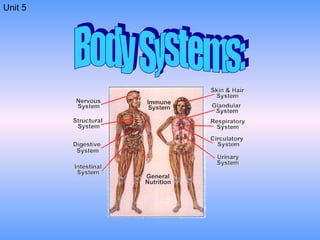
Unit 5 Health Book
- 1. Body Systems: Unit 5
- 2. Integumentary System Lesson One Chapter 15
- 3. Lesson 1 Your skin has two main layers which include the epidermis – the outer, thinner layer of your skin, and the dermis – the inner, thicker layer of your skin. The epidermis is made of both dead and living cells. New cells arise to the surface to replace the old ones. Some of the cells in the epidermis produce melanin , the pigment that gives skin, hair and the iris of the eyes their coloring. Melanin determines the color in your skin. The dermis is made up of connective tissue that gives the skin its elasticity, or spongy, flexible quality. Under the dermis is tissue called the hypodermis. Although it is not part of your skin, it attaches your skin to the bone and muscle. Structure of the Skin
- 6. The Skeletal System Lesson 2
- 10. Nervous System Chapter 16 Lesson 1
- 12. Lesson 2 Care of the Nervous System To keep your nervous system functioning well, you need: -Regular exercise -Proper nutrition -Adequate rest and sleep Problems Accidents can damage or destroy nerve tissue Degenerative diseases can destroy nerve tissue in the brain or spinal column. Drug and alcohol use can lead to nervous system disorders. Head Injuries Any direct blow to the head can lead to possible brain injury. A concussion, a temporary disturbance of the brain’s ability to function, is the most common and mildest kind of brain injury. A contusion is more serious though and can result in a coma. Spinal Injuries Injury on the spinal cord can lead to paralysis. An injury at neck level may result in quadriplegia and paralysis is in both the arms and legs. Injury at the chest level or lower affects the legs and lower body. Degenerative Diseases Parkinson’s disease: caused by degeneration of the nerve cells within the brain that modify nerve impulses transmitted from the motor areas of the brain. Multiple sclerosis: the destruction of the myelin sheath that surrounds nerve fibers in the brain and spinal cord. Alzheimer’s disease: causes general mental deterioration Other Disorders Epilepsy: a disorder of the nervous system that is characterized by seizures Cerebral Palsy: a group of nonprogressive neurological disorders that are the result of damage to the brain before birth, during birth, in the newborn period, or in early childhood.
- 14. Chapter 17 The Circulatory and Respiratory Systems
- 18. Respiratory System Problems The respiratory system is a common site of infection. Some more serious infections of it are: Bronchitis Asthma Pneumonia Tuberculosis Emphysema Sinusitis
- 19. Your Digestive and Urinary Systems Chapter 18
- 20. Lesson 1 The Digestive System Functions Digestion- the mechanical and chemical breakdown of foods for use by the body’s cells. Absorption- the passage of digested foods from the digestive tract into the circulatory system. Elimination- the expulsion of undigested food or body wastes Structure Digestion begins before you take a bite of food when the aroma of food activates the salivary glands. The Mouth and Teeth The primary function of your teeth is to break food you eat into smaller pieces. Mastication is the process of chewing. Organs That Aid Digestion The Liver The Gallbladder The Pancreas
- 22. Your Body's Reproductive System Chapter 19
- 27. THE END